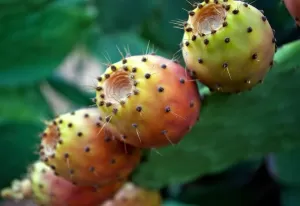|
1878 |
Bulletin of The Torrey Botanical Club. New York, Feb., 1818
§ 2I4. Opuntia Ficus-Indica, DC.-It may not be out of place to note a few things about the Opuntia Ficus-Indica, of Southern Italy and other Mediterranean countries. Its main use... |
|
The Journal of the Torrey Botanical Society |
|
1975 |
Titratable Acids in Opuntia ficus indica L.
Accumulation of acidity in spiny and spineless Opuntia joints jluctuated daily due to crassulacean acid metabolism (CAM) in Golan Height and coastal plain. The acidity reached higher concentrations in... |
|
|
|
1980 |
Biophysical properties of Opuntia ficus-indica mucilage
The purified mucilage from Opuntia ficus-indica is a high MW polysaccharide which behaves as a polyelectrolyte. Viscosity of its solution is dependent on the Ca2+ ion concentration and on... |
|
Phytochemistry |
|
1993 |
CO2 Exchange and Growth of the Crassulacean Acid Metabolism
CO2 uptake, water vapor conductance, and biomass production of Opuntia ficus-indica, a Crassulacean acid metabolism species, were studied at CO2 concentrations of 370, 520, and 720 pL 1-' i n... |
|
|
|
1996 |
Native Cultivars of Cactus Pear in México
Cactus pears or prickly pears (Opuntia spp. Cactaceae) are omnipresent plants of the Mexican landscape and have great historical and ethnobotanical significance. Ripe fruits and tender cladodes (pads), have been... |
|
|
|
1999 |
Frugivorous Drosophila simulans begins to exploit Opuntia ficus-indica cladodes
The introduction of exotic plants creates potential new niches for endemic animals. European tradespeople brought the cactus Opuntia ficus-indica in the 16th century from Mexico to Europe to serve... |
|
|
|
2002 |
Fodder Potential Of Opuntia Ficus-Indica
The objective of this study was to investigate the fodder potential of Opuntia ficus-indica. Samples taken from a plant grown in a greenhouse were analysed for DM, ash, CP,... |
|
|
|
2003 |
Oil cactus pear (Opuntia ficus-indica L.)
Seeds and pulp of cactus pear (Opuntia ficus-indica L.) were compared in terms of fatty acids, lipid classes, sterols, fat-soluble vitamins and b-carotene. Total lipids (TL) in lyophilised seeds and... |
|
|
|
2006 |
Cactus Pear Production Systems In Tigray, Northern Ethiopia
Ethiopia has some of the lowest socioeconomic indicators in the world. About 90% of the population earn their living mainly from agricultural activities, which are mostly based on rainfed... |
|
|
|
2006 |
Forage Potential of Opuntia Clones
Short term gas exchange measurements and long term field trials have confirmed the several fold greater water to dry matter conversion efficiency of cactus than C3 and C4 plants. The... |
|
|
|
2007 |
Physicochemical Characterization of Nopal Pads (Opuntia ficus indica) and Dry Vacuum Nopal Powders as a Function of the Maturation
This paper presents the physicochemical and nutrimental characterization of fresh nopal (Opuntia ficus indica, Redonda variety) and nopal powder produced at different stages of development. Nopal powder was obtained... |
|
|
|
2010 |
NOPAL (Opuntia ficus indica L.), DELICIOSO Y MEDICINAL
La planta de nopal tiene su origen en México, pero tiene una distribución muy amplia ya que se encuentra de manera natural en toda América y presente en los... |
|
|
|
2010 |
Opuntia Ficus-Indica as an Extremophile
Opuntia Ficus-Indica as an Extremophile
|
|
|
|
2011 |
Evaluation of oxalates and calcium in nopal pads (Opuntia ficus-indica var. redonda) at different maturity stages
The content of calcium oxalate and calcium in powder from Opuntia ficus-indica (nopal pad) was investigated. Atomic absorption spectrometry was used to evaluate the calcium and calcium oxalate contents.... |
|
|
|
2011 |
Development of a regeneration protocol through indirect organogenesis
An indirect organogenesis regeneration protocol for Opuntia ficus-indica (L.) Mill var “Blanco sin Espinas” is described. One centimeter square cladode explants sections from previously micropropagated prickly pear plants were cultured... |
|
|
|
2012 |
Nopal Cactus (Opuntia Ficus-Indica) as a Holographic Material
The nopal cactus (Opuntia ficus-indica) releases a substance through its mucilage, which comes from the degradation of pectic substances and chlorophyll. Combined in a polyvinyl alcohol matrix, this substance can... |
|
|
|
2012 |
Pharmacological Actions of opuntia ficus indica
Cactus (Opuntia ficus-indica) belongs to the family Cactaceae. Family Cactaceae is reported to contain about 130 genera and nearly 1500 species. This plant is native of Mexico and it is... |
|
|
|
2014 |
Antileishmanial activity of Opuntia ficus-indica fractions
Cladodes and fruits of Opuntia ficus-indica are used in traditional medicine for the treatment of abscess and skin inflammation. It was therefore interesting to assess whether an antileishmanial activity... |
|
|
|
2015 |
Characterization of Calcium Compounds in Opuntia ficus indica as a Source of Calcium for Human Diet
Analyses of calcium compounds in cladodes, soluble dietary fiber (SDF), and insoluble dietary fiber (IDF) of Opuntia ficus indica are reported. The characterization of calcium compounds was performed by... |
|
|
|
2015 |
Characterization of crystalline structures in Opuntia ficus-indica
This research studies the crystalline compounds present in nopal (Opuntia ficus- indica) cladodes. The identification of the crystalline structures was performed using X-ray diffraction, scanning electron microscopy, mass spectrometry, and... |
|
|
